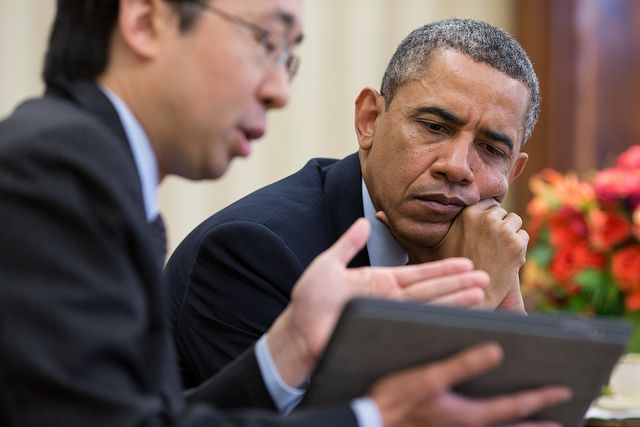President Obama is in the thick of a full-court press on the economy. He spoke last week in Galesburg, Illinois, about the need for a middle-out approach to the economy, which some economists believe will benefit low-income workers and strengthen the consistently eroding middle class. Sitting Presidents don’t give newspaper interviews all that often, and Obama spoke with the Times over the weekend and didn’t skip a beat on the economy. The country’s devastating income inequality was front and center.
“If we don’t do anything, then growth will be slower than it should be,” he told The Gray Lady. “Unemployment will not go down as fast as it should. Income inequality will continue to rise. Wages, incomes, savings rates for middle-class families will continue to be relatively flat. And that’s not a future that we should accept.”
The president’s lengthy interview with the Times was heavy on rhetoric and light on actual problem solving, which has been the transparent purpose of his recent spate of speeches — he wants to push the dialogue on the economy before Congress is back in session this fall. But the economic problems Obama is addressing — low wages, an eroding middle class, unemployment — are not being fixed at particularly meteoric rates. And income inequality, as the president has said time and again, is only getting worse.
Issues like poverty and joblessness, problems typically associated with urban areas, are taking root across the country. Since 2000, poverty rates have shot up at nearly double the rate in suburbs as it has in cities. New data from the Associated Press found that four out of 5 American adults “struggle with joblessness, near-poverty or reliance on welfare for at least parts of their lives.” Nearly 85 percent of working-age adults could be faced with economic insecurity, broadly defined as “a year or more of periodic joblessness,” by 2030. The middle class is diminishing and any sense of economic stability is disappearing with it.
Poverty and, if we really unravel the knot, economic insecurity, can’t simply be pegged to a specific demographic. There are 46.2 million poor people in America, 15 percent of the nation’s population. And while larger swaths of minorities are below the poverty line — poverty rates for blacks and Hispanics are nearly triple — whites make up over 41 percent of the poor.
So what do all these insanely depressing, yet somewhat unsurprising numbers mean? Cyclical poverty can’t be written off as an urban plight anymore. But what can we do to fix it? (That’s the $10 million question!) Obama has a few ideas, albeit Democratic truisms, that I can get behind:
“Every economist will tell you that if we are being smart about growth and we’re thinking about jobs and we’re thinking about the middle class, but we’re also thinking about fiscal responsibility, then what we should be doing is making sure that the drop-off in government spending on vital things like education and infrastructure don’t go down too fast, and that rather we look at what the real problem is, which is long-term health care costs.”
Education and infrastructure are as relevant in American cities as they are in smaller suburban towns. Investing in infrastructure — dare we ask for some form of easily accessible transit? — creates jobs for the local economy. If that infrastructure is implemented in a smart fashion, it should ideally spur some economic growth and create jobs. And more money poured into education can do its part to help foster some sort of upward mobility for future generations, not to mention create valuable jobs for teachers and school staff right now.
But right now we’re mired in the precipitous decline of the middle class and poverty concentration in both our cities and suburbs. It’s going to be a long climb back to stability — like the continually modest job growth we see in monthly job reports — but it might behoove Congress to listen to the president and continue spending on infrastructure and education. These are sound investments in both our current and future economic success.
The Equity Factor is made possible with the support of the Surdna Foundation.

Bill Bradley is a writer and reporter living in Brooklyn. His work has appeared in Deadspin, GQ, and Vanity Fair, among others.

















